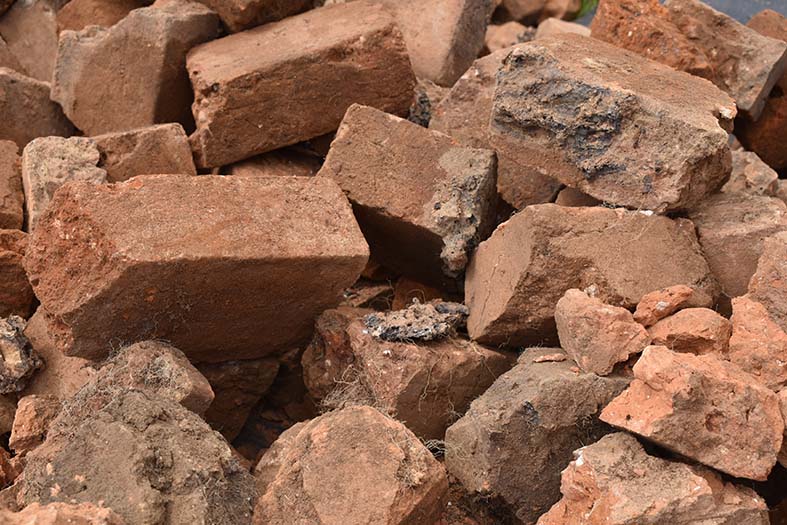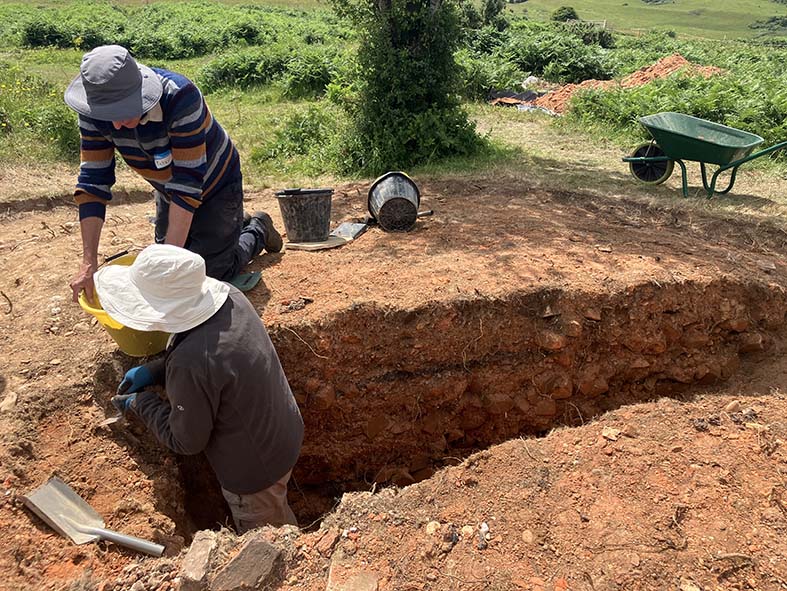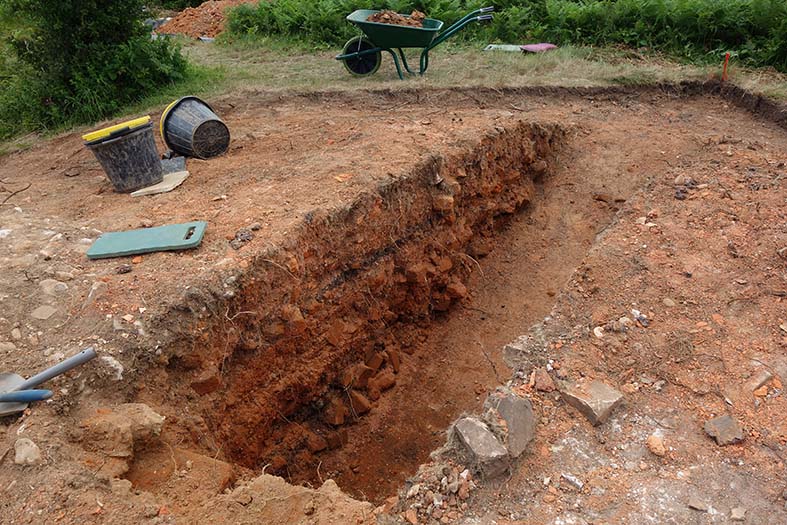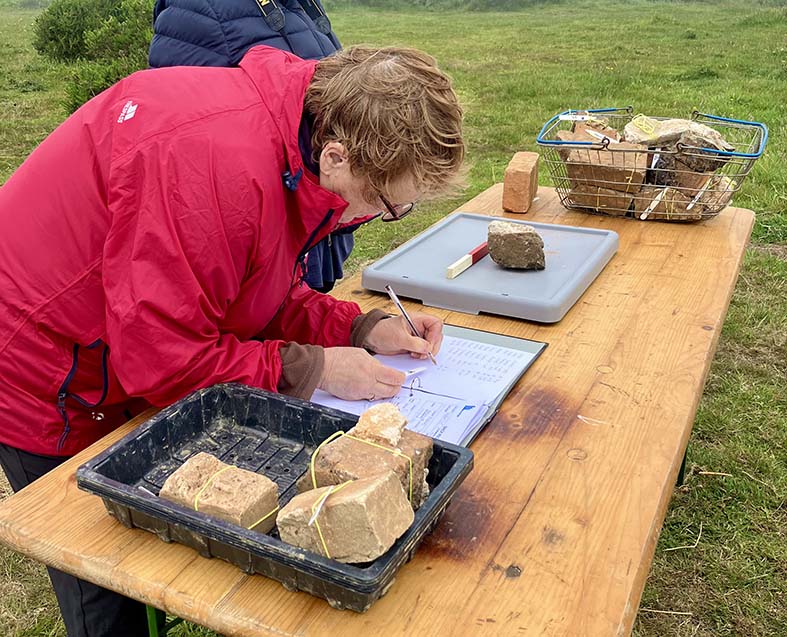This is an occasional update from Society for Post-Medieval Archaeology members about their research projects, field work and latest activities. If you would like to see your work featured, send an email to website@spma.org.uk
Investigating a small estate brickworks in the Valley of Stones, Dorset
During the Summer of 2025, Past Participate CIC and Historic England carried out fieldwork at a post-medieval brickworks in Dorset, UK.
Past Participate are a non-profit community archaeology company that focuses on research-led programmes in Dorset and south-west England. In 2024, they were awarded a grant from the National Lottery Heritage Fund for a project Living Amongst the Sarsens, to learn more about the archaeology of the Valley of Stones National Nature Reserve, West Dorset.

This £275,844 project is 90% funded by the National Lottery Heritage Fund (NLHF) with additional support from Natural England, and provides a suite of activities from lectures and guided walks, through to excavation and other field-based research. The project is revealing new archaeological evidence of human use of the valley over millennia with the aim to commission new, permanent interpretation panels and a digital map.
As part of their 2025 fieldwork, Past Participate excavated the site of a small brick kiln and possible clay working area in the Valley of Stones with volunteers from the local community. At the same time as the excavation, staff from Historic England’s Archaeological Investigation Team carried out a complementary earthwork survey of the site, targeting the central core of the brickworks, including the excavated areas.
The Historic England team has already completed an aerial survey of the wider area, as part of a project to improve understanding of scheduled monuments in the environs. The aerial survey revealed the complexity of the brickworks. As well as the known features of the kiln, old clay pits and spoil heaps, a previously unidentified area for clay working and brick drying, plus the location of two small buildings (since demolished), were seen and mapped from lidar data. That provided the impetus for Past Participate to investigate further.
The kiln was probably built by the Bridehead Estate (as it was on their land) and used to make bricks for the farm buildings on the estate. While we have not yet discovered the date of its initial construction, it was likely to have been in use at several points during the 18th and 19th centuries. Part of a clay pipe bowl that can be dated to 1820-1840 was found in the upper level of the kiln trench during the excavation, probably dating the last activity at the site. The pits where the clay was extracted are still visible as ponds, and there are many other traces in the immediate landscape related to the wider brickworks.
Past Participate are currently writing up the excavation report and teasing out the details, and the Historic England team are wrapping up the results of their wider landscape survey including a hachured plan to support interpretation of the kiln site. More information will be available once all this is complete.




Anne Teather (Past Participate CIC) and Rebecca Pullen and Katy Whitaker (Historic England)
LGTBQ+ History Month 2025 – 37 Looe Street, Plymouth, UK










37 Looe Street is a gallery/workshop space in Plymouth. It’s the sister project of the collective consultancy ButCH (Bureau for the Contemporary & Historic). ButCH includes SPMA Council member Lara Band. The gallery and consultancy are both are queer-facing, heritage-oriented, and community-interested.
This February we’re collaborating with @Pride_in_Plymouth – an archiving project that has brought together treasures of the city’s queer history, and @tsotsc.plym – a community story sharing project. We’ve co-created an exhibition of stories and images of queer lives in the city – JoJo the nonogenarian lesbian, Ted in the Lion’s Den, the legendary radical bookshop In Other Words – and are hosting a series of workshops:- shanty-writing, badgemaking, queer archive salon.
Check our Instagram @37LooeStreet for activities and opening hours. ButCH are @everydayelvis, @aapiccini, @_laraband, Nadia Bartolini & Sarah May.
LGBTQ+ History Month 2025 – the story of Cattie and Alice
The construction of the River Thames Embankments in London in the mid-late 19th century changed the relationship between Riverside communities and the river. The construction of walls between land and water removed and buried countless waterside businesses. Many of these are not recorded in historic documents, but left archaeological traces on the foreshore. In tracing the changing nature of the riverside community at Chelsea between 1851-1891, SPMA President Dr Hanna Steyne found many unexpected glimpses of people from marginalised groups. Around the collected historical and archaeological data, alternative, imagined histories of the Thames have been told.





The story of Cattie and Alice is one grounded in both the changing relationships with water in Chelsea, but also of the changing nature of the community between 1851 and 1891. It also captures wider changing attitudes around homosexual relationships in early 1890s London, the era of the widely publicised trial of Oscar Wilde for sodomy. Cattie and Alice met as teenagers living and working for Eliza Podio at her laundry at 4a Queens Road West, Chelsea. By 1891 they had taken over ownership of the laundry as business partners, and continued to live together at the same address.
The laundry was located round the corner from Oscar Wilde’s house on Tite Street, where he was living in 1891. By 1901 Alice had married a man, Charles, who had a young son by another woman and Cattie is listed as a boarder. They are all living together, with Alice and Charles’ 1 year old, and two servants. By 1911 Cattie had moved out and was living on her own in Walthamstow. You can learn more about the rich stories of the River Thames communities in Dr Steyne’s PhD thesis.


LGBTQ+ History Month 2025 – Helsinki City Museum M/S Baltic Queers exhibition
The Helsinki City Museum’s exhibition M/S Baltic Queers – Experiences of LGBTQAI+ Migration showcases the varied life stories of individuals who have migrated from Finland, Sweden, Denmark, Russia, and the Baltic states since the 1960s. It explores the reasons behind the migration of sexual and gender minorities and examines how the Baltic Sea both connects and separates these regions. The exhibition tells very personal stories of people and examines how material culture manifests their experiences.
SPMA Council Member Sanna Lipkin reflects, ‘…the exhibition was very personal, including photographs and references to interviews, and the items people had taken with them when leaving and seeing what they had stored for decades related to their “life-changing” travel was deeply touching. It was one of the best ones I’ve visited for a while.’ The exhibition continues until 2 March, entry is free of charge. Find out more at the Helsinki City Museum website.


LGBTQ+ History Month 2025 – Hollis Croft. A Matter of Time
Hollis Croft. A Matter of Time is an archaeological comic by Mili Rajic and illustrated by Dave Howarth. The story is set in Victorian Sheffield. It uses historical and material evidence to explore LGBTQ+ identities within a rigid 19th century society. More than historical fiction, it is an archaeologist’s interpretation of past lives through excavation and research. The book highlights how archaeology can reconstruct marginalised narratives often erased from history, challenging the notion that queer identities are a modern construct. By embedding LGBTQ+ experiences within a carefully reconstructed setting, it promotes a more inclusive understanding of the past. A full review will be published in the Post-Medieval Archaeology Journal.

Notes from the Field – Dr Katerina Velentza (University of Hull)

The Community Waterscapes project is unravelling the city of Hull’s (UK) rich heritage of living with water. We generate a dialogue around the intricate relationship between water, community, and material culture within the city, documenting how these elements have collectively shaped people’s understanding of watery environments over time.
Stories shared by the community help us identify tangible and intangible heritage that is currently lost, unknown, under-represented or downgraded. They create a record of the changing cultural landscape in Hull.
Through this bottom-up heritage research approach, Community Waterscapes documents lived experiences, local knowledge, and environmental understandings related to life in a dynamic estuarine city. FInd out more from the project website.
Notes from the Field – Dr Sarah Inskip (University of Leicester)

The Tobacco, Health and History Project explores the impact of tobacco consumption on population health in England and the Netherlands from 1600-1900AD. It uses interdisciplinary analysis of archaeological skeletal remains. To detect tobacco use, the team developed a novel biomolecular approach (metabolomics) to look for molecules associated with tobacco use in bone.
This has revealed high tobacco consumption rates by women. The team found that oral disease and respiratory disease risk was significantly increased by tobacco use. In addition, intersectional health impacts based on biological sex, and rural or urban industrialised living conditions have also been identified. Read more on the project website.
Notes from the Field – Alessandro Camiz (Università degli Studi “Gabriele d’Annunzio” – Pescara)

Our council member Dr Alessandro Camiz has recently been involved in organising an international workshop on Abruzzo’s (Italy) historical heritage. Castel di Sangro: technologies and design was held 20-27 July at Museo Civico Aufidenate in Castel Di Sangro.
An opening conference illustrated the most recent research on the historical heritage of Abruzzo and Castel di Sangro. During the workshop 30 students from Italy, Spain, Greece and Türkiye were led by highly qualified tutors in digital survey, laser survey, documentation and design.
Lessons covered the operational aspects of the research during the workshop. The workshop results have been presented publicly and will be published. The image (above) is a laser scan of the courtyard. Watch a TV presentation about the workshop on YouTube. View a 3D model of a wooden sculpted head:
Maddalena, Head, XIX century by g.verdiani_DIDA on Sketchfab
Notes from the Field – David Caldwell (Independent scholar)

Our member Dr David Caldwell has recently co-authored a book with Victoria Oleksy and Bess Rhodes. The Battle of Pinkie, 1547: The Last Battle Between the Independent Kingdoms of Scotland and England was published by Oxbow in 2023. Using contemporary records and archaeological evidence, they offer new considerations for this well-documented battle.
David’s publication on nearly a decade of archaeology in Finlaggan will be published in 2025. The Archaeology of Finlaggan, Islay: Excavations at the Centre of the Lordship of the Isles, 1989-1998 will include results of the excavation and survey field work of post-medieval settlements and fortifications as well as lead mines. It is published by the Society of Antiquaries of Scotland.
Notes from the Field – Susana Pacheco (CFE-HTC, Nova University of Lisbon FCT)

As part of my PhD project “The Industrial HER. An archaeological vision of women’s lives and stories through photography”, this summer, I’m developing a somewhat different type of fieldwork. Perhaps it is better to call it laboratory work, or is it?
The main goal of this project is to understand the role played by women in the Portuguese industry, focusing essentially on the textiles and canning sectors. Recognising the problems they faced, both directly as members of a community in which they were not always well-accepted or sometimes not even treated as human beings, or indirectly as they were erased from documents, historiography and archaeological records. To fulfil this goal, a different type of materiality was chosen – photographs.
For that reason, photographic objects are being archaeologically analysed, just like one archaeologist would do with ceramics. Following a new methodology, these artefacts are being analysed in every possible way. Their materiality is being considered. Their formats, signs of use, marks of the passage of time, dimensions, biographies, and every aspect that one would consider for a piece of ceramics and beyond.
At the same time, their decoration (the image itself) is also being analysed, or “excavated”. In the words of Ralph Mills: “Objects within the same stratified deposit, physically and temporally, form an assemblage. While this might be within a three-dimensional soil layer, it can also be a ‘deposit’ depicted in the two-dimensional stratigraphy of a painting or photograph that captures assemblages frozen together in time. It is therefore possible to ‘excavate’ an image in an archaeological sense” (2017: 116). So, one could say that a photograph is an archaeological context. Therefore, it can be excavated just like any type of ruin.
In this sense, the fieldwork being developed for the past few months (and that will be carried out during the next ones as well) consists of an archaeological analysis (and “excavation”) of this unconventional type of post-medieval materiality. Their study allows us to learn so much about the historical subjects (women) that are the main focus of this project. Like almost no other materiality, they enable us to see their facial expressions. An interpretation of their emotions, recognising their possible fears and understanding their relations with the people and objects surrounding them in their daily lives are just some of the possibilities they offer archaeologists.
This fieldwork (or laboratory work) brings immense new perspectives on the lives of these agents who are often undervalued by Portuguese archaeology.
